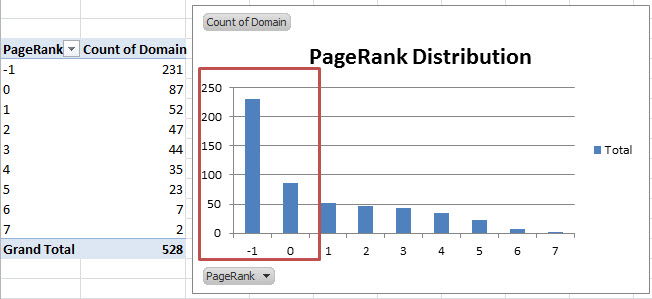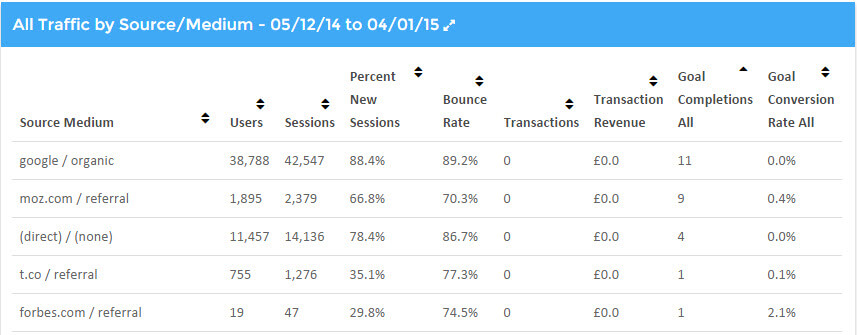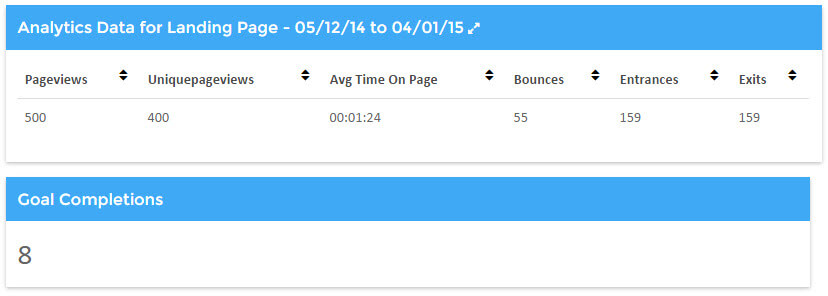Link volume alone has not been a reliable, correlative metric for rankings for almost a decade
Take a look at the top 6 ranking URLs for the keyword “Wordpress Hosting” in the UK. I’ve used Moz’s keyword difficulty tool to scrape the ranking results, and URL Profiler to fetch the link data from Majestic.
We have ranking URL, external links and referring domains to the page and at a domain level. There’s really no pattern here:
There’s simply not enough of a correlation between link volume alone and rankings for this keyword for a conclusion to be drawn on what drives the ranking result.
The infinite complexity of search ranking factors
We all know there’s a great deal more complexity to determining what factors drive search engine rankings (Take a look: Moz Ranking Factors | Searchmetrics Ranking Factors). Domains that look strong at first glance can have hidden issues, and they’re almost always due to what’s lurking deep in their link profiles.
When you look at search results that are extremely competitive (“Bingo” in the UK is a good one to watch), you see sites that should be closer to top position. Mecca Bingo, for example, sits at the top of page 2 but has comparable linking root domains to the site in 1st place – foxybingo.com. It’s being outperformed by domains with half of the link volume. This observation should lead to the conclusion that their backlink profile needs some investigation, and probably a comprehensive link removal / disavow.
The data certainly indicates that there’s much, much more to SEO than link volume acquisition.
Some links have an exponentially higher value
A long time ago, the only data Internet marketers had to determine the quality of a link were the referrals they received. Obviously, this BG (Before Google) period was before my time, but check in with industry veterans like Danny Sullivan and I believe that’s the crux of what link building meant back then.
Google’s arrival changed all of that by bringing us a links influenced ranking algorithm. They brought us PageRank, an exponential scale to represent “some approximation of a page’s importance or quality”. As time went on, use of the “Toolbar PageRank” metric from around 2000 or so became more and more popular. It wasn’t always reliable, nor was it updated often.
As time passed, lots of tools companies, like Moz, Majestic and later aHrefs attempted to engineer their own quality indicators. Usually named “*rank”, like MozRank or TrustRank.
Though each score was a little different, they were all broadly based on similar maths. The scores were based on an Log scale of base 8 (or thereabouts). In essence, this would mean that a link from a page of say, rank 4 would be worth significantly more than a link from a page of rank 3.
8 times more, in fact.
While PageRank is essentially no longer a publicly accessible score, the tools providers battle on in their pursuit of a correlative score to rankings. Those scores indicate at least some of the potential value of a link. This is important and we’ll get back to that in a moment.
As I mentioned, some links are worth more than others. So I could explain this statement a little better we put together a clever interactive chart.
Click a point on the chart, then click another point. It’ll tell you how many more times any one value might be “worth” (for want of a better word: this is purely hypothetical) than the other.
Click clear if you want to do it again:
(Hold CTRL to change the first value)
First value:
Second value:
Second value is 0 times greater
So, some links are worth more than others.
Links on the higher end of whatever scale you choose are clearly valued more highly by link builders. You would need to acquire 262,144 rank 2 links to match the value of our theoretical rank 8 link in this chart!
Setting minimum quality standards
Link building isn’t quite as simple as choosing a page quality score and targeting it. While running an outreach campaign, you’d expect to see minimum tolerances set for quality. For example, a site with a minimum Domain Authority, with a set number of inbound linking root domains (“inbound linking root domain diversity”), for example.
You can go quite far into link checking, of course. During outreach, evaluating a potential linking domain has a number of time consuming, critical checks including making sure there’s no history of a penalty or obvious ranking drop, making sure the site doesn’t host paid links or low quality articles.
Essentially you’re making sure there’s an authentic set of measurable behaviours that imply a genuine site: lots of social activity, comments, new links, mentions, a genuine audience whose interests are relevant to your brand’s content and so on. This is where “link building” by its classic SEO definition becomes much more aligned to marketing and PR. We’re targeting sites that we know have a relevant audience and if you took search out of the equation entirely, there’d be a benefit to having that link in place.
The quality has to be on point. “Volume” alone can lead to a link profile that resembles this:

Building lots of links without reasonable minimum standards set will always lead to a link penalty. The resulting process of audit and removal is time consuming and not particularly profitable!
Valuing your best links
We’re lucky to have acquired a diverse range of links, mostly organic through experiments and our own guides.
Those sorts of links tend to send spikes in traffic and help us gain more diversity in our link profile. This process of correlates well to growth in organic visibility and drives lots of nice referrer traffic.
With outreach, comes an additional opportunity to focus in on domains that have audiences that might convert:

Moz, for example, sends a lot of converting traffic from their recommended agencies page. This is good.

Link volume isn’t a great way to evaluate the potential of an SEO appointment
In short, set better KPIS.
A carefully thought out, iterative campaign will always deliver a diverse range of links. If we build and promote our content, provided it has appeal, it will work. Of course “will work” is subjective and should be based on a firm set of outcomes and goals.
I’d argue that a properly targeted outreach methodology can provide better and more meaningful levels of performance and that your assessment should be based on better KPIs: referrals and conversions from the links and by proxy, a gradual but continuous improvement in rankings and organic traffic.
